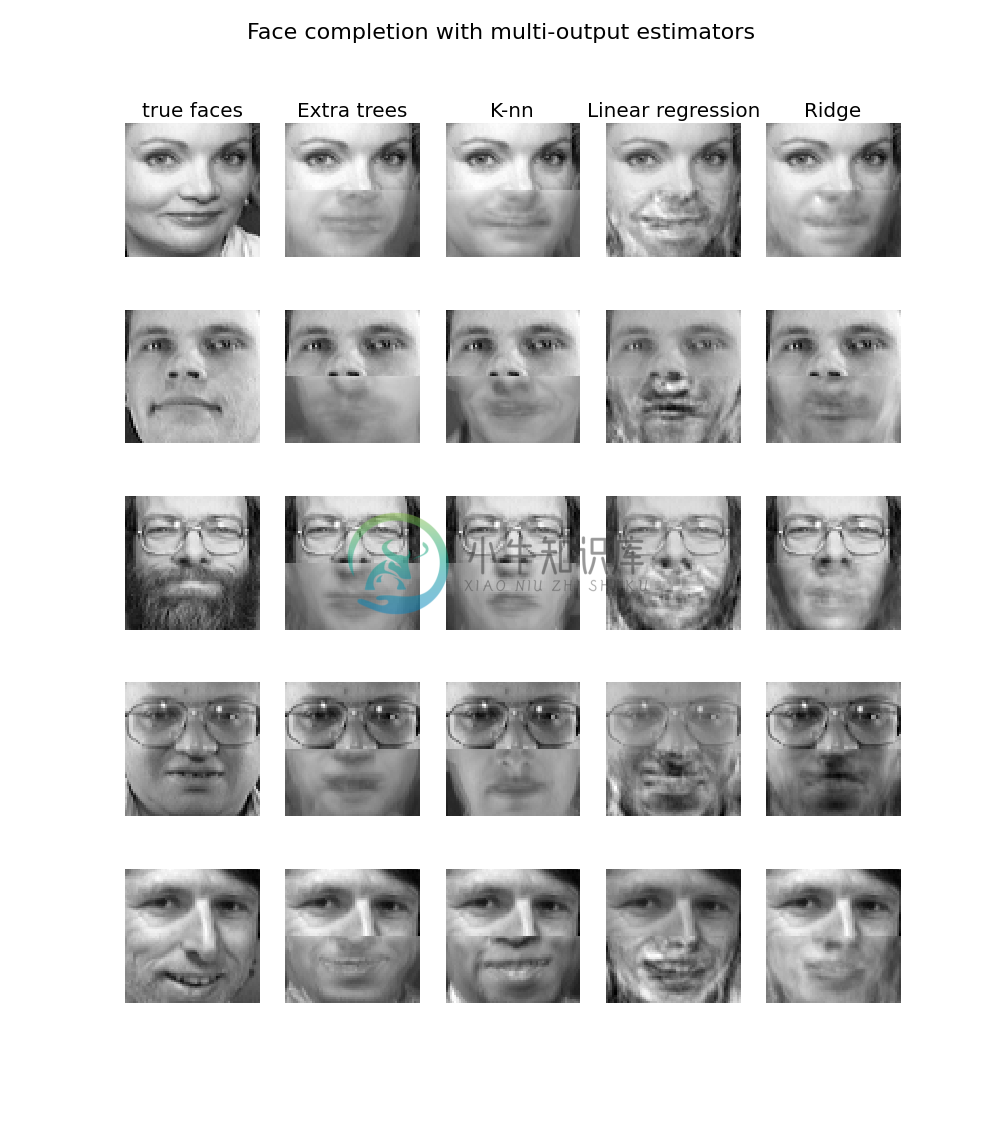通用范例 General Examples - Ex 7: Face completion with a multi-output estimators
优质
小牛编辑
136浏览
2023-12-01
通用范例/范例七: Face completion with a multi-output estimators
http://scikit-learn.org/stable/auto_examples/plot_multioutput_face_completion.html
这个范例用来展示scikit-learn如何用 extremely randomized trees, k nearest neighbors, linear regression 和 ridge regression 演算法来完成人脸估测。
(一)引入函式库及内建影像资料库
引入之函式库如下
sklearn.datasets: 用来绘入内建之影像资料库sklearn.utils.validation: 用来取乱数sklearn.ensemblesklearn.neighborssklearn.linear_model
使用 datasets.load_digits() 将资料存入, data 为一个dict型别资料,我们看一下资料的内容。
from sklearn.datasets import fetch_olivetti_facesdata = fetch_olivetti_faces()targets = data.targetdata = data.images.reshape((len(data.images), -1))
| 显示 | 说明 |
|---|---|
| (‘images’, (400, 64, 64)) | 共有40个人,每个人各有10张影像,共有 400 张影像,影像大小为 64x64 |
| (‘data’, (400, 4096)) | data 则是将64x64的矩阵摊平成4096个元素之一维向量 |
| (‘targets’, (400,)) | 说明400张图与40个人之分类对应 0-39,记录每张影像是哪一个人 |
| DESCR | 资料之描述 |
前面30个人当训练资料,之后当测试资料
train = data[targets < 30]test = data[targets >= 30]
测试影像从100张乱数选5张出来,变数test的大小变成(5,4096)
# Test on a subset of peoplen_faces = 5rng = check_random_state(4)face_ids = rng.randint(test.shape[0], size=(n_faces, ))test = test[face_ids, :]
把每张训练影像和测试影像都切割成上下两部分:
X人脸上半部分,
Y人脸下半部分。
n_pixels = data.shape[1]X_train = train[:, :np.ceil(0.5 * n_pixels)]y_train = train[:, np.floor(0.5 * n_pixels):]X_test = test[:, :np.ceil(0.5 * n_pixels)]y_test = test[:, np.floor(0.5 * n_pixels):]
(二)资料训练
分别用以下四种演算法来完成人脸下半部估测
extremely randomized trees(绝对随机森林演算法)k nearest neighbors(K-邻近演算法)linear regression(线性回归演算法)ridge regression(脊回归演算法)
ESTIMATORS = {"Extra trees": ExtraTreesRegressor(n_estimators=10, max_features=32,random_state=0),"K-nn": KNeighborsRegressor(),"Linear regression": LinearRegression(),"Ridge": RidgeCV(),}
分别把训练资料人脸上、下部分放入estimator.fit()中进行训练。上半部分人脸为条件影像,下半部人脸为目标影像。
y_test_predict为一个dict型别资料,存放5位测试者分别用四种演算法得到的人脸下半部估计结果。
y_test_predict = dict()for name, estimator in ESTIMATORS.items():estimator.fit(X_train, y_train)y_test_predict[name] = estimator.predict(X_test)
(三)matplotlib.pyplot画出结果
每张影像都是64*64,总共有5位测试者,每位测试者分别有1张原图,加上使用4种演算法得到的估测结果。
image_shape = (64, 64)n_cols = 1 + len(ESTIMATORS)plt.figure(figsize=(2. * n_cols, 2.26 * n_faces))plt.suptitle("Face completion with multi-output estimators", size=16)for i in range(n_faces):true_face = np.hstack((X_test[i], y_test[i]))if i:sub = plt.subplot(n_faces, n_cols, i * n_cols + 1)else:sub = plt.subplot(n_faces, n_cols, i * n_cols + 1,title="true faces")sub.axis("off")sub.imshow(true_face.reshape(image_shape),cmap=plt.cm.gray,interpolation="nearest")for j, est in enumerate(sorted(ESTIMATORS)):completed_face = np.hstack((X_test[i], y_test_predict[est][i]))if i:sub = plt.subplot(n_faces, n_cols, i * n_cols + 2 + j)else:sub = plt.subplot(n_faces, n_cols, i * n_cols + 2 + j,title=est)sub.axis("off")sub.imshow(completed_face.reshape(image_shape),cmap=plt.cm.gray,interpolation="nearest")plt.show()


